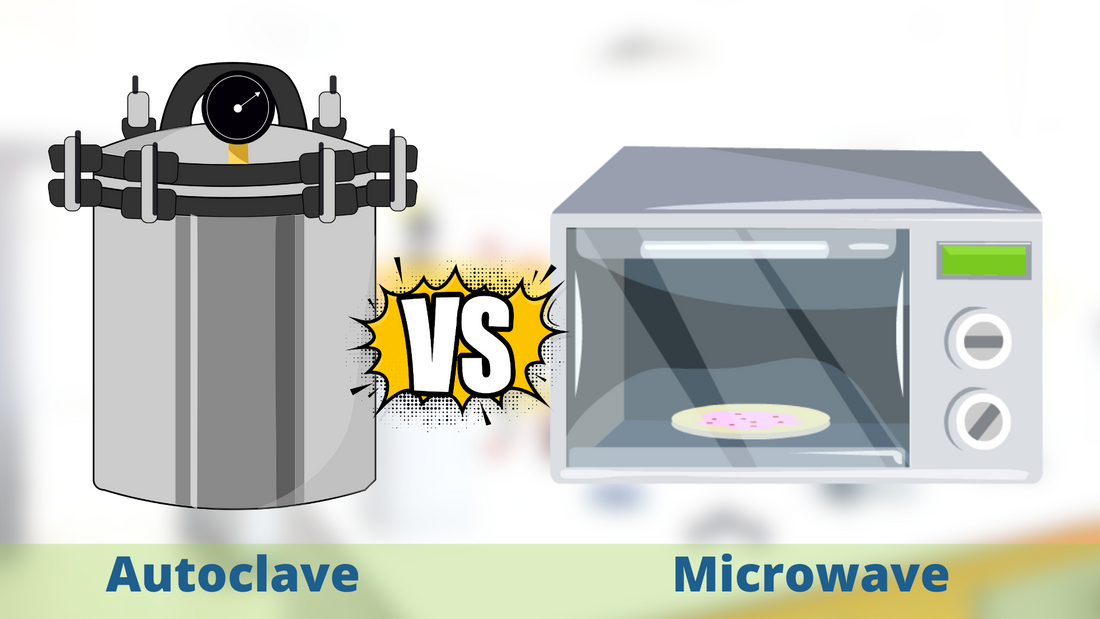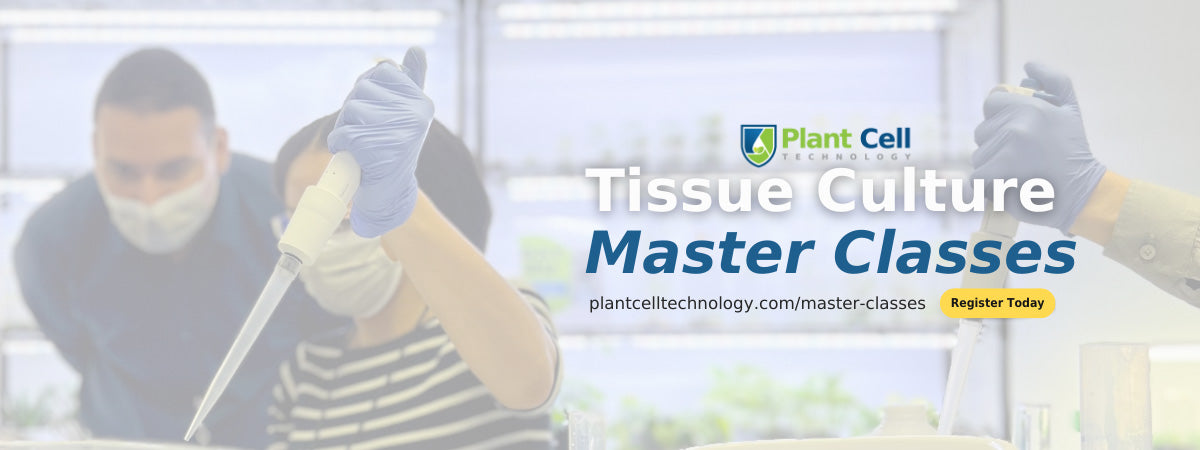
Why is an Autoclave Better Than a Microwave For Sterilization?
As a content and community manager, I leverage my expertise in plant biotechnology, passion for tissue culture, and writing skills to create compelling articles, simplifying intricate scientific concepts, and address your inquiries. As a dedicated science communicator, I strive to spark curiosity and foster a love for science in my audience.


Overview
Autoclaves and microwaves, while serving different functions, are both integral to the sterilization processes in laboratory settings. They are widely utilized to ensure the disinfection of media, cultures, and a variety of tools and equipment necessary for plant science, saving endangered plants, and even medical research purposes.
In the specialized field of plant tissue culture, the importance of these sterilization devices becomes particularly pronounced. Tissue culture involves regenerating plants from small sections of tissues or individual cells within a controlled lab environment. This delicate process demands that every element involved - from the smallest pipette to the culture media - is thoroughly sterilized. Mature plants in their natural environment possess innate abilities to combat pathogens and pests.
However, in the lab, isolated plant tissues and cells are bereft of these natural defenses. Without stringent sterilization, these tissues and cells become highly susceptible to contamination, which can lead to the failure of the experiment, often manifested as the death of the explant. This scenario underscores the need for an aseptic environment - one completely devoid of any microorganisms.
Sterilization, in this context, is more than just a routine cleaning. It's a comprehensive process aimed at eliminating all microbial life from the tools, equipment, and media that will be utilized in tissue culture experiments. This process is critical not only to safeguard the integrity of the experiment but also to achieve success in the cultivation of disease-free plants.
An aseptic environment also encompasses the broader aspects of the tissue culture facility. This includes the culture area itself and extends to the meticulous cleaning and sterilization of the hands of those performing the tissue culture techniques. Maintaining such a sterile environment is vital to prevent any form of microbial contamination that could jeopardize the health and viability of the cultured tissues or cells.
Therefore, the role of autoclaves and microwaves in maintaining these sterile conditions cannot be overstated. Each of these sterilization methods brings unique benefits and is suited to different types of materials and requirements of the tissue culture process. Their proper use ensures that the high standards of cleanliness and sterility required for successful tissue culture are consistently met.

A multitude of sterilization methods exists to cater to the varying needs of different materials. The adage “One size fits all” is not applicable in this context; it is imperative to consider the specific properties of each item before subjecting it to sterilization. This necessitates an understanding of the material’s composition, the underlying principles of the chosen sterilization method, and how the material interacts with the sterilizing agents involved in the process.
Some common sterilization techniques include autoclave, microwave, filter sterilization, hot air oven, sterilization using chemicals, like alcohol and bleach, gas sterilization, and radiation sterilization.
This article, however, narrows its focus to two of the most widely used and discussed sterilization methods in contemporary practice: autoclaving, which leverages steam under pressure, and microwave sterilization, which uses electromagnetic radiation to generate heat. These processes are at the forefront of sterilization techniques due to their effectiveness and widespread adoption in various settings.
Autoclaving
Autoclaving, known for its steam sterilization capabilities, is widely recognized as an effective method for purging liquid handling products of viruses, bacteria, and spores in laboratory environments. This technique hinges on the concept that water's boiling point can be increased when under heightened pressure, a principle put into action within an apparatus known as an autoclave or steam sterilizer.
Diving into the types of autoclaves, they are differentiated based on their operational mechanics.
Types of Autoclave
- Gravity Autoclave: This variant operates by leveraging gravity to evacuate air. Steam is channeled into the autoclave from above, which then forces the air out through a vent at the bottom. This method is particularly effective for solid, non-porous objects like glassware and metallic tools, although its efficiency may wane when dealing with porous materials. The gravity autoclave is further divided into horizontal and vertical types, distinguished by the direction in which their doors open and how the materials are loaded for sterilization.
- Vacuum Autoclave: These autoclaves employ a vacuum pump to extract air from the chamber prior to steam introduction. The resultant vacuum state facilitates deeper steam penetration, making it an optimal choice for porous substances, textiles, and intricately shaped objects. The vacuum not only ensures the removal of air from within the materials but also enhances the overall effectiveness of the sterilization process.

Working Mechanism of Autoclave
The autoclave sterilization cycle involves three phases:
- Purge Phase: In this phase, the air is removed from the autoclave chamber and the vacuum system present in the machine replaces it with steam.
- Exposure (Sterilization) Phase: After the air is removed, the sterilizer drain closes, and steam starts building up inside the chamber. It increases the temperature and pressure in the chamber to the desired level. Then, the equipment and tools are held at the set particular chamber for a set period of time to achieve complete sterilization.
- Exhaust Phase: At this phase of the autoclave, steam is released from the chamber and the inside environment is restored at the ambient temperature and pressure.

Figure: An illustrative representation of the three phases of autoclave sterilization.
Who Uses Autoclave? A range of labs and industries in medicine, veterinary, dentistry, plant biotechnology, and microbiology have routine applications involving autoclaves.
Microwave Sterilization Technique
Domestic household microwaves have been used to sterilize materials like agar nutrient media, plastic culture vessels, and dental tools. Microwaves use electromagnetic radiation as energy for sterilization processes. It vibrates water molecules that undergo friction to produce heat and kill microorganisms.
Microwaves are a faster way to prepare tissue culture plates and allow the addition of heat-sensitive components such as antibiotics as they are not destroyed by microwaves.

Comparison Between Microwave and Autoclave Sterilization Technique
When weighing the merits of microwave versus autoclave sterilization techniques, it is clear that each has its own set of strengths and limitations. Autoclaving is widely regarded as the gold standard in laboratory sterilization due to its effectiveness in achieving uniform heat distribution, making it suitable for a broad array of materials, including those that can withstand significant heat and pressure. For effective sterilization using microwaves, several variables must be carefully managed, including the media's volume, the type of vessel used, the material's physical state, the intensity of the microwave's power, and the exposure duration.
Microwaves, however, fall short when it comes to sterilizing liquids and large batches of tissue culture media. Their inherent limitation in energy distribution can lead to uneven sterilization, which is particularly problematic for materials that require consistent exposure to eliminate all microbial life. This uneven distribution also makes microwaves less suitable for sterilizing slow-growing organisms, where complete and uniform exposure is crucial.

On the other hand, microwave sterilization offers advantages in terms of speed, cost, and environmental impact. It consumes less energy and is generally more economical, both in operation and because it requires fewer materials to facilitate the sterilization process.
Ultimately, the choice between microwave and autoclave sterilization cannot be distilled to a simple "better" or "worse" as it largely depends on the specific requirements of the sterilization task at hand. Nevertheless, should technological advances in microwave sterilization be realized, particularly in terms of heat distribution and microbial eradication, this method could become a more competitive and cost-effective alternative for laboratory and industrial applications.
HOW DOES PLANT CELL TECHNOLOGY HELP YOU TO ACHIEVE YOUR TISSUE CULTURE GOALS?

Plant Cell Technology (PCT) plays a pivotal role in advancing the field of tissue culture by providing an array of specialized products and services designed to optimize and streamline the cultivation process.
The PCT Store boasts a comprehensive inventory that includes Murashige and Skoog (MS) media, agar, gellan gum, Plant Preservative Mixture (PPM™), culture vessels, the Biocoupler™, and even laminar flow hoods, all curated to support and enhance tissue culturing procedures.
Beyond the provision of high-quality products, Plant Cell Technology extends its expertise through personalized consultation services. These services are tailored to meet the needs of tissue culturists of all scales, offering immediate and effective solutions to a wide range of tissue culture-related challenges. Clients have the flexibility to choose between virtual one-on-one consultation calls or on-site lab visits, ensuring that guidance is available at every stage of the tissue culture journey.
From the initial steps of setting up a lab to troubleshooting contamination issues and overcoming specific procedural hurdles, PCT's support is comprehensive and continuous.
In addition to these services, PCT is excited to announce a series of upcoming Master Classes, specifically curated for enthusiasts in the realm of tissue culture. These classes present an invaluable opportunity to gain insights and knowledge from seasoned experts with extensive experience, ranging from 10 to over 30 years in the field.
To discover how Plant Cell Technology can contribute to the success of your tissue culture endeavors, keep exploring the many resources we have for you on this website. The website is a gateway to explore the full spectrum of PCT's offerings and learn how they can be integrated into your tissue culture practices to achieve superior outcomes.
Join us in the journey of tissue culturing — where every step forward is supported by Plant Cell Technology.
Grow with us and Happy Culturing!
Blog Categories
View by Level
Popular Blogs

How Samantha Bridges the Gap Between the Nursery and the Lab
The Introduction Building a tissue culture program from the ground up requires more than just scientific knowledge—it requires the grit...
Read More
Understanding The Synthetic Seed Technology
Introduction Let’s be honest: traditional plant propagation can be a logistical nightmare. If you’re working with recalcitrant species—those stubborn plants...
Read MoreSubscribe to Our Newsletter








Join the conversation
Your email address will not be published. Required fields are marked